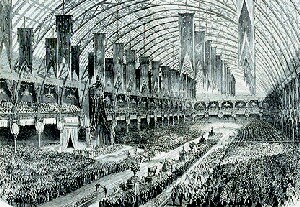|
1 |
 Copyright: L'Illustration, Nr. 1272, 13.7.1867, S. 21f |
|
1 |
 Copyright: L'Illustration, Nr. 1272, 13.7.1867, S. 21f |
At the London World Exposition of 1851, the general public had already berated the degradation of art to a decorative secondary role at the industrial exhibition. In spite of this, the art exhibition in 1867 was again intended to play only a secondary role. Although works of art formed the first group in the classification system, the exhibition commission, whose members consisted primarily of industrialists and economists, allocated only one of the smallest halls to this section. As a consequence, the paintings were hung in five and more rows above each other and were scarcely visible to the visitors.
Some countries, such as Belgium, Holland and Switzerland, as well as Bavaria, thereupon integrated their art exhibitions into their own pavilions in the park and were therefore able to exhibit up to 200 paintings. In contrast, other countries, such as Turkey and Brazil, had to be satisfied with space for no more than seven works in the exhibition in the palace which was dominated by France. Added to this, the constitution of the selection panel for painting and drawing proved to be very problematical. The panel consisted in equal parts of relatives of members of the exhibition commission, members of the Académie des Beaux-Arts and artists who had already been awarded medals or were members of the Légion d´Honneur. Representative intentions were the prime motive, as the panel was intended to guarantee a conservative and retrospective approach to the art exhibition.
The younger naturalists or the future impressionists such as Monet, Renoir, Degas, Cézanne or Berther Morisot were not represented. Apart from these, a large number of important French artists felt themselves excluded – and following the example of Courbet in 1855, some of these organised their own exhibitions outside of the exposition site. Manet, for example, exhibited paintings which later became famous, such as Breakfast in the country or his Panorama de l'Exposition universelle, in a gallery close to the Pont d´Alma. And not far away, Courbet, although he had provided the show in the palace with four pictures, had installed his own pavilion, which was conceived as a permanent exhibition of realism.
In contrast, in the exhibition palace, one wanted in particular, apart from landscape painting by Rousseau or Français, to see exotic art or images of history in the academic, neo-classicist style. In the event, the walls were mainly covered with works of the panel members, who included Meissonier????, Gérôme, Dupré, Bouguereau, Millet, Daubigny, Huet and Corot, who, other than was the case with Courbet, were each represented with between eight and fourteen paintings. Genre pictures were particularly popular and represented. Although only works were supposed to be exhibited which had been completed after 1st January 1855, the exhibition proved in the final analysis to be a retrospective of recognised artists. Art was, in its undecorated, crowded and uncomfortable presentation, one product among many, only an "agreeable accessoire", as Charles Blanc, who was himself a panel member, expressed it in 1867 in the Le Temps newspaper. The exhibition contributed especially to the success of Meissonier???. But with the increasing loss of political stability, the general public soon lost interest in academic painting.
| Year: 1867 | City: Paris | Country: France |
| Duration: 1st April - 3rd November 1867 | ||